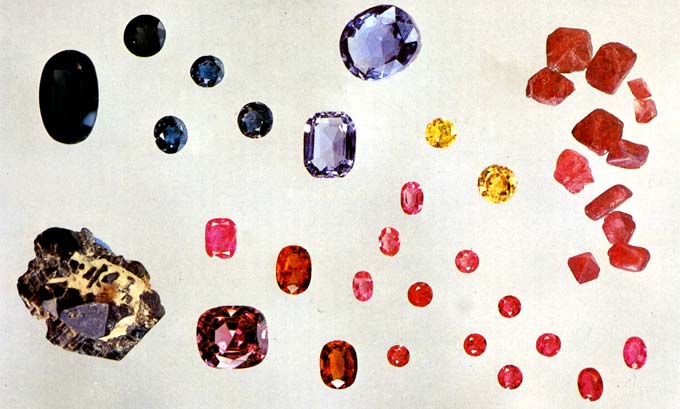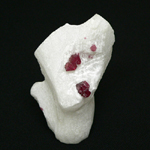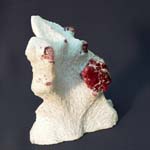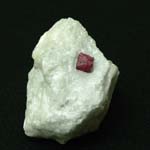Spinel (oxides): Spinel
 Diagnostic card.
Diagnostic card.
On the picture. Crystals of noble spinel on white calcite. Below: crystals of blue spinel (Franklin, New Jersey).
Mg Al 2 O 4
Cubic cubic system
Hardness 8
Specific weight 3,6-3,75
Cleavage is absent
Cracked shell
Color is colorless, red, blue, blue, brown-black
Color in powder white
Glitter glass

 The name spinel received, probably in the form of crystals: from the Latin spinella - a small spine. Spinel happens to be almost all colors, but ruby-red stones, whose color is caused by the presence of chromium, are most appreciated. Large transparent stones are very rare. Especially rare star spinel with a 4-beam star. The blue variety of spinel is sensitive to temperature increase.
The name spinel received, probably in the form of crystals: from the Latin spinella - a small spine. Spinel happens to be almost all colors, but ruby-red stones, whose color is caused by the presence of chromium, are most appreciated. Large transparent stones are very rare. Especially rare star spinel with a 4-beam star. The blue variety of spinel is sensitive to temperature increase.
Dark green and black opaque spinel is called ceylonite (according to the old name of the island of Sri Lanka), but the name "pleonast" is preferable for it. Which means "surplus" in Greek, for the abundance of faces in crystals. A brown variety of spinel is called picotite, yellow - rubicellum (diminutive form from French "ruby"), and pink - balas- or balet-ruby (in the place of the find in Afghanistan).
As an independent mineral, spinel began to be isolated only a century and a half ago. Before that, it was ranked among rubies, especially since ruby and spinel are often found together in nature. Some of the famous historical rubies turned out to be spinel, for example, such stones from the treasury of the British crown, like the oval 5-centimeter "Ruby of the Black Prince" in the crown of England and "Ruby Timur" weighing 361 carats in the breast chain. Both these stones are polished only on natural faces. Teardrop-shaped spinels in the Wittelsbach crown (1830) were also considered rubies. Spinel was a "ruby" with a mass of 398.72 carats in the great imperial crown of Catherine II. Made in 1762 I. Pose.
It is also called noble spinel for the beauty of crystals used in jewelry. It can have a different color - from brown-black (due to the presence of iron - pleonast) to blue, from colorless to ruby red (red spinel). Glitter is glass. In nature, crystals are often observed in perfect octahedral form and are usually twinned. In red and blue spinels, various inclusions of black octahedrons of hercinite (a rare spinel with aluminum and bivalent iron) are marked, oriented in the form of parallel filaments. In addition, well-formed crystals of calcite, dolomite, apatite, zircon, olivine and rutile can be present.
Chemical composition - content (in%): MgO - 28.2; AlO3 - 71.8; The admixtures of iron, chromium, zinc, and manganese are common. Hexaoctahedral symmetry. Cleavage is imperfect in (111). It occurs mainly in the form of octahedral crystals (other simple forms are rare), usually of small dimensions. The twins of the intergrowth in (111) are characteristic, according to the spinel law. Isometric grains and granular aggregates are less common. In real spinel crystals, usually one or a pair of opposite faces of the octahedron is most developed. In this case, the spinel twins acquire a characteristic triangular-plate shape with bifurcated (entering) angles.
Lal is red spinel, very hard, transparent, with a strong gloss. Blood-red spinel, the color of which is due to chromium salts, is very similar to ruby. From a chemical point of view, spinel is a complex oxide of magnesium and aluminum.

Diagnostic signs.
Spinel fluoresces in the ultraviolet light rather intensely. The pink variety becomes light yellow when heated; However, upon cooling, the original color is restored.
Origin.
Spinel is found in carbonate, magmatic rocks and in shales. For use as a precious stone, it is extracted mainly from alluvial deposits.
Place of Birth.
The most famous are deposits in Cambodia, India, Burma, Thailand and Sri Lanka. Spinel is found in Brazil (state of Espiritu Santo), in the Urals, in Australia, in Madagascar and in the United States.
The main deposits of spinel are placers of Burma (Mogoka) and Sri Lanka. Much less important are the findings in Anatolia (Turkey). Afghanistan. Brazil. Thailand, USA (New Jersey). In the CIS, a spinel deposit is available in the Pamir. The two largest crystals of spinel (one highly rounded, the other in the form of an octahedron) weighing 520 cents each are in the British Museum of Natural History in London.
Synthetic spinel entered the market in the 20s of the XX century. It imitates not only natural spinel, but also many other stones. Spinel is easily confused with amethyst, chrysoberyl, garnet, ruby, sapphire, topaz. However, specialists diagnose spinel very simply - because it does not have birefringence.
Application.
Everyone knows the use of spinel in jewelry. Instances that are not suitable for their quality for these purposes are used in the manufacture of abrasive powders and in the manufacture of watch mechanisms.
Use in jewelry.
Jewelery varieties of spinel are extracted from alluvial deposits. Especially valuable are red (ruby spinel, or ruby-balas), as well as blue and green spinels. The cut is often oval. For transparent and translucent varieties, a cut in the shape of a cabochon or sphere is used. Many famous stones, previously considered rubies, are now redefined as spinels. Of these, it is worth mentioning the famous "Ruby of the Black Prince", or "Ruby of Timur" (its original origin is from India), stored in the Treasury of the British Crown.
The cost of spinel is quite high, but it varies considerably depending on the color, which depends both on popularity and availability on the market. By now, a large number of synthetic single crystals are known. However, only some of them have found wide enough use in jewelry business.





- Ghetchellit - "New Almaden blend" - arsenide and antimony sulfide (modern sulfosol)
- Antimony is a toxic metal (semimetal) , widely used in metallurgy, medicine and engineering
- Zirconium - a rare and undiscovered metal and the most dangerous precious stone in oxide and salt
- Gold - yellow dangerous and poisonous metal of modern accurate digital and cable technologies
- Sulfur is a golden-yellow toxic substance and a sign of active volcanic activity
- Cadmium is an undisputed toxic silvery metal unknown to a wide range of people
- Lead - a poisonous gray imitator of metallic silver and toxic metal blende
- Arsenic is a classic poison of medieval and modern poisoners and medicine in medicine
Poisonous and radioactive dangerous stones and minerals
** - poisonous stones and minerals (mandatory check in the chemical laboratory + explicit indication of toxicity)
** - radioactive stones and minerals (mandatory check on the standard dosimeter + ban on open sales in case of radioactivity exceeding 24 milli / g / h + additional measures of population protection)
Catalog of minerals and semi-precious stones of the world by groups
** - poisonous stones and minerals
** - radioactive stones and minerals


Comments
When commenting on, remember that the content and tone of your message can hurt the feelings of real people, show respect and tolerance to your interlocutors even if you do not share their opinion, your behavior in the conditions of freedom of expression and anonymity provided by the Internet, changes Not only virtual, but also the real world. All comments are hidden from the index, spam is controlled.